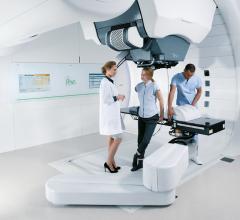
February 17, 2009 - Doctors in Hong Kong have carried out the first treatments in south-east Asia using RapidArc radiotherapy technology from Varian Medical Systems, and treated a 74-year-old patient with localized prostate cancer.
Clinicians at the Pamela Youde Nethersole Eastern Hospital (PYNEH) in Hong Kong said the first treatment took two to three minutes to deliver, much faster than conventional IMRT (intensity modulated radiotherapy) treatments.
“IMRT treatments are time-consuming because tumors are targeted by a complex sequence of fixed radiation beams from multiple angles but the RapidArc treatment is dramatically faster," said Dr. T.K. Yau, consultant radiation oncologist. “The RapidArc treatment can produce comparable or even better dose conformity compared with IMRT treatments, but with shorter treatment times. It means that more of our patients can be treated with advanced IMRT-quality treatments.”
Dr. Yau said the hospital now plans to expand the range of RapidArc treatments to include other pelvic tumors and head and neck cancers. PYNEH is one of six public cancer centers in Hong Kong.
Doctors at PYNEH treat patients using three Varian linear accelerators including a Clinac 23Ex accelerator equipped with RapidArc radiotherapy technology, as acquired in 2008 thanks to a private donation. Dr. Yau says his department plans to equip a second accelerator with RapidArc in the coming months.
For more information: www.varian.com


 July 09, 2024
July 09, 2024 









